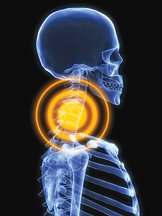For most people with chronic neck pain, this can be a difficult exercise. That's why you can begin your exercise program by doing simple chin tucks while sitting or standing.
Simply tucking your chin in and holding it until you fatigue will help reactivate these muscles. You can start with 12 repetitions of this exercise, working your way up to three sets of 12 repetitions each. Ensure you take adequate rest (several minutes) in between each set.
Once you get comfortable with basic sitting/standing chin tucks, you can try doing the exercise lying down. The goal is to be able to do it 12 times, holding each one until you fatigue. The next goal is to work your way up to three sets of 12 repetitions, with rest in between each set. Then work your way to three sets of 15 repetitions and then three sets of 20 repetitions. Remember, this is a marathon, not a race. The goal is to increase the endurance of your muscles rather than their strength. Your neck is designed to carry the weight of your head all day, not to lift trains or buses! That's why building up endurance should be your first priority.
Remember, the neck muscles are like any other muscle in our body. With long-term pain or injury, the muscles get weak and get tired quicker. By first "balancing" the weak muscles and increasing their endurance, you will be prepared to progress to more challenging strengthening exercises. As research and guidelines conclude, combining this with your chiropractic care will lead to the best outcomes and improvement in your chronic neck pain.
 Do You Have Chronic Neck Pain? Test Your Neck Muscles
Do You Have Chronic Neck Pain? Test Your Neck Muscles
The following exercises are a great way to test if your deep neck muscles are easily fatigued and thus contributing to your neck pain. They're also a great way to train the muscles so they don't fatigue as quickly, which can help relieve your chronic pain.
Lying chin tuck: Gently lift your head off the floor with your chin tucked in. You should be able to hold this position for 10 seconds. If your chin goes up, head tilts back, or your head begins to shake and you are unable to hold the position, this indicates fatigue of the deep neck muscles, which may be contributing to your pain.
Sitting chin tuck: Simply tuck the chin in. Make sure you don't tilt your head forward. Keep chin tucked in and head back. This is a good exercise to start with if you're suffering from chronic neck pain and are unable to perform lying chin tucks for a sustained period of time.
Take-Home Points
- In most cases, don't expect anyone to find a single "cause" for your neck pain.
- Stay as active as you can; simple exercises and reducing mental stress can help.
- A combination of therapies, including chiropractic care, may be needed.
Source: The Bone and Joint Decade 2000-2010 Task Force on Neck Pain and Its Associated Disorders
Jasper Sidhu, DC, graduated from Canadian Memorial Chiropractic College in 1994 and opened the Downtown Injury Rehab Centre in Windsor, Ontario, incorporating vibration training into the rehabilitation part of his practice. He is vice president of clinical services for WAVE Manufacturing (www.wavexercise.com).

